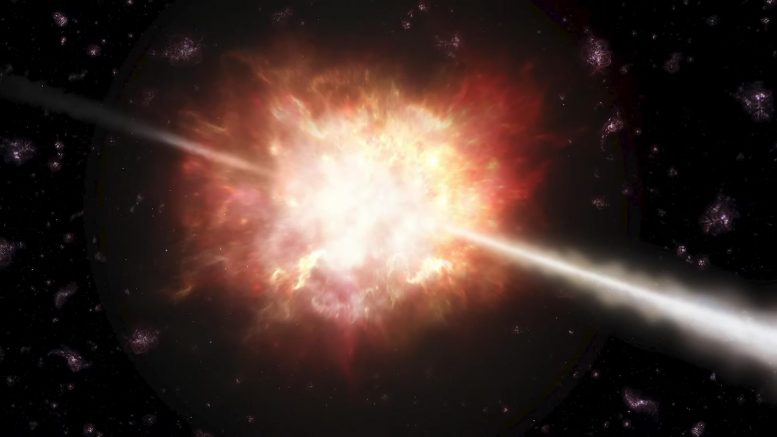
Astronomers using NASA’s Hubble Space Telescope have traced the locations of five brief, powerful radio blasts to the spiral arms of five distant galaxies.
Hubble Tracks Down Fast Radio Bursts to Galaxies’ Spiral Arms
They come from anywhere in the sky: mysterious flashes of radio energy that disappear in the blink of an eye. They’re called fast radio bursts (FRBs), and astronomers have spotted roughly 1,000 of them over the past 20 years. But they come and go so quickly that researchers have only been able to trace about 15 of them to their home galaxies, all are massive and far from Earth. After that, their trail runs cold. Astronomers haven’t been able to track the bursts to the neighborhoods where the radio waves were beamed. Their location could offer clues to the cause of one of the most enigmatic events in modern astronomy.
Astronomers are now using the Hubble Space Telescope as an intergalactic sleuth on the trail of this cosmic mystery. With Hubble they have tracked five FRBs to the spiral arms of five distant galaxies. But surprisingly, these powerful events don’t come from the brightest regions, which blaze with the light from hefty stars. These clues help researchers rule out several possible explanations for the brilliant flares, such as the explosive deaths of the youngest, most massive stars. The researchers’ results favor an increasingly popular theory, that the bursts come from magnetars, intensely magnetic remnants of collapsed dead stars.
Fast radio bursts, or FRBs, are extraordinary events that generate as much energy in a thousandth of a second as the Sun does in an entire year! Astronomers using NASA’s Hubble Space Telescope have traced the locations of five brief, powerful FRBs, which are near or on their host galaxies’ spiral arms. The research helped rule out some of the possible stellar objects originally thought to cause these brilliant flares. Credit: NASA’s Goddard Space Flight Center
These Brilliant Flares Originate from Young, Massive Galaxies
Astronomers using NASA’s Hubble Space Telescope have traced the locations of five brief, powerful radio blasts to the spiral arms of five distant galaxies.
Called fast radio bursts (FRBs), these extraordinary events generate as much energy in a thousandth of a second as the Sun does in a year. Because these transient radio pulses disappear in much less than the blink of an eye, researchers have had a hard time tracking down where they come from, much less determining what kind of object or objects is causing them. Therefore, most of the time, astronomers don’t know exactly where to look.
Locating where these blasts are coming from, and in particular, what galaxies they originate from, is important in determining what kinds of astronomical events trigger such intense flashes of energy. The new Hubble survey of eight FRBs helps researchers narrow the list of possible FRB sources.
Flash in the Night
The first FRB was discovered in archived data recorded by the Parkes Radio Observatory on July 24, 2001. Since then astronomers have uncovered up to 1,000 FRBs, but they have only been able to associate roughly 15 of them with particular galaxies.
“Our results are new and exciting. This is the first high-resolution view of a population of FRBs, and Hubble reveals that five of them are localized near or on a galaxy’s spiral arms,” said Alexandra Mannings of the University of California, Santa Cruz, the study’s lead author. “Most of the galaxies are massive, relatively young, and still forming stars. The imaging allows us to get a better idea of the overall host-galaxy properties, such as its mass and star-formation rate, as well as probe what’s happening right at the FRB position because Hubble has such great resolution.”
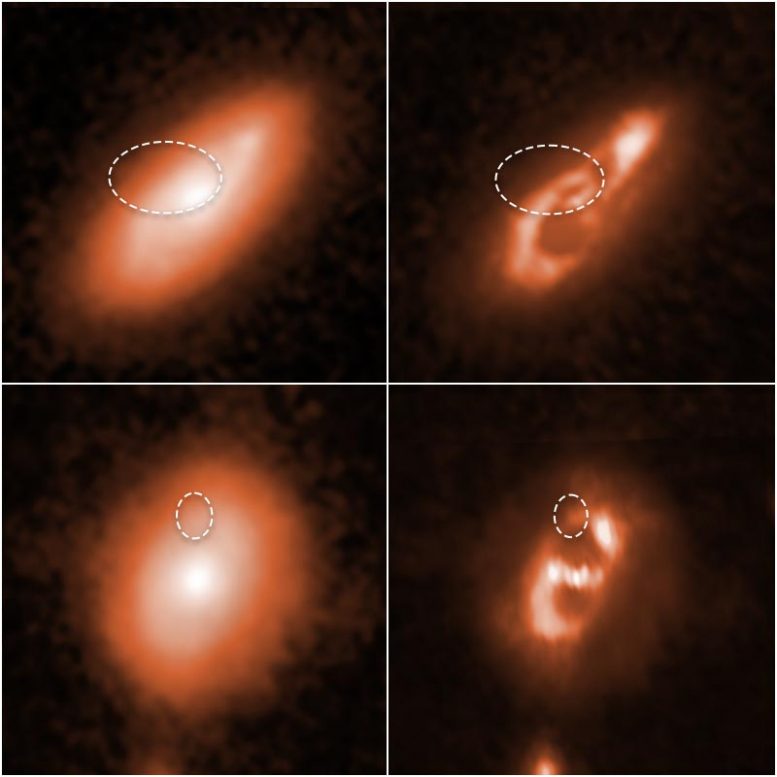
Astronomers using the Hubble Space Telescope have tracked down two brief, powerful radio bursts to the spiral arms of the two galaxies shown above. The two images at the left show the full Hubble snapshots of each galaxy. The two digitally enhanced images on the right reveal each galaxy’s spiral structure in more detail. The catalog names of the bursts are FRB 190714 (top row), and FRB 180924 (bottom row). The galaxies are far from Earth, appearing as they looked billions of years ago. The dotted oval lines in each of the four images mark the location of the brilliant radio flares. Credit: Science: NASA, ESA, Alexandra Mannings (UC Santa Cruz), Wen-fai Fong (Northwestern), Image Processing: Alyssa Pagan (STScI)
In the Hubble study, astronomers not only pinned all of them to host galaxies, but they also identified the kinds of locations they originated from. Hubble observed one of the FRB locations in 2017 and the other seven in 2019 and 2020.
“We don’t know what causes FRBs, so it’s really important to use context when we have it,” said team member Wen-fai Fong of Northwestern University in Evanston, Illinois. “This technique has worked very well for identifying the progenitors of other types of transients, such as supernovae and gamma-ray bursts. Hubble played a big role in those studies, too.”
The galaxies in the Hubble study existed billions of years ago. Astronomers, therefore, are seeing the galaxies as they appeared when the universe was about half its current age.
Many of them are as massive as our Milky Way. The observations were made in ultraviolet and near-infrared light with Hubble’s Wide Field Camera 3.
Ultraviolet light traces the glow of young stars strung along a spiral galaxy’s winding arms. The researchers used the near-infrared images to calculate the galaxies’ mass and find where older populations of stars reside.
Location, Location, Location
The images display a diversity of spiral-arm structures, from tightly wound to more diffuse, revealing how the stars are distributed along these prominent features. A galaxy’s spiral arms trace the distribution of young, massive stars. However, the Hubble images reveal that the FRBs found near the spiral arms do not come from the very brightest regions, which blaze with the light from hefty stars. The images help support a picture that the FRBs likely do not originate from the youngest, most massive stars.
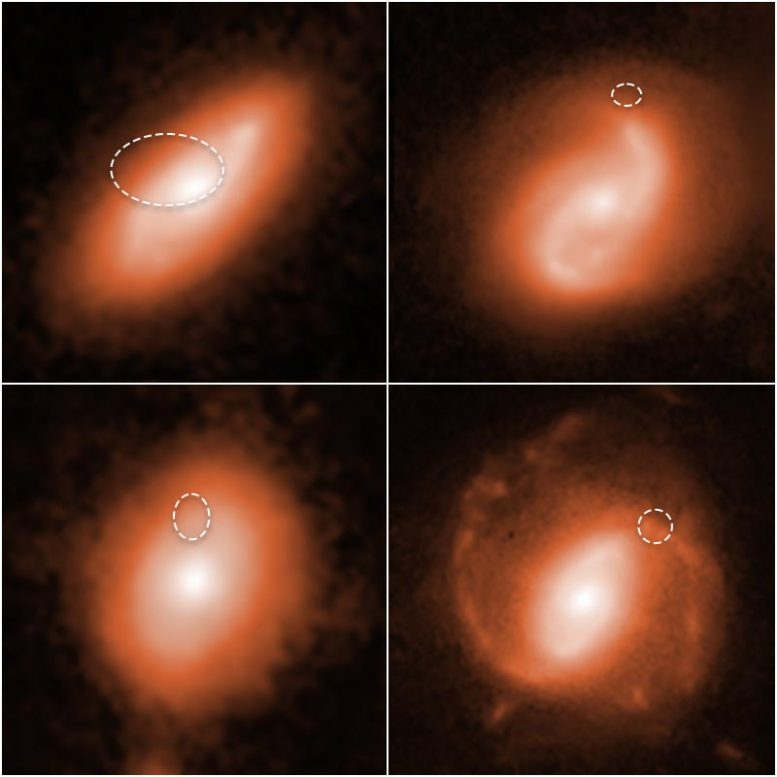
Hunting for the neighborhoods of enigmatic fast radio bursts (FRBs), astronomers using the Hubble Space Telescope tracked four of them to the spiral arms of the four distant galaxies shown in the image. The bursts are cataloged as FRB 190714 (top left), FRB 191001 (top right), FRB 180924 (bottom left), and FRB 190608 (bottom right). Because these radio pulses disappear in much less than the blink of an eye, researchers have had a hard time tracking down where they come from. With the help of Hubble’s sharp vision, astronomers pinpointed their locations (denoted by the dotted oval lines) to the galaxies’ spiral arms. Credit: Science: NASA, ESA, Alexandra Mannings (UC Santa Cruz), Wen-fai Fong (Northwestern), Image Processing: Alyssa Pagan (STScI)
These clues helped the researchers rule out some of the possible triggers of types of these brilliant flares, including the explosive deaths of the youngest, most massive stars, which generate gamma-ray bursts and some types of supernovae. Another unlikely source is the merger of neutron stars, the crushed cores of stars that end their lives in supernova explosions. These mergers take billions of years to occur and are usually found far from the spiral arms of older galaxies that are no longer forming stars.
Magnetic Monsters
The team’s Hubble results, however, are consistent with the leading model that FRBs originate from young magnetar outbursts. Magnetars are a type of neutron star with powerful magnetic fields. They’re called the strongest magnets in the universe, possessing a magnetic field that is 10 trillion times more powerful than a refrigerator door magnet. Astronomers last year linked observations of an FRB spotted in our Milky Way galaxy with a region where a known magnetar resides.
“Owing to their strong magnetic fields, magnetars are quite unpredictable,” Fong explained. “In this case, the FRBs are thought to come from flares from a young magnetar. Massive stars go through stellar evolution and become neutron stars, some of which can be strongly magnetized, leading to flares and magnetic processes on their surfaces, which can emit radio light. Our study fits in with that picture and rules out either very young or very old progenitors for FRBs.”
The observations also helped the researchers strengthen the association of FRBs with massive, star-forming galaxies. Previous ground-based observations of some possible FRB host galaxies did not as clearly detect underlying structure, such as spiral arms, in many of them. Astronomers, therefore, could not rule out the possibility that FRBs originate from a dwarf galaxy hiding underneath a massive one. In the new Hubble study, careful image processing and analysis of the images allowed researchers to rule out underlying dwarf galaxies, according to co-author Sunil Simha of the University of California, Santa Cruz.
Although the Hubble results are exciting, the researchers say they need more observations to develop a more definitive picture of these enigmatic flashes and better pinpoint their source. “This is such a new and exciting field,” Fong said. “Finding these localized events is a major piece to the puzzle, and a very unique puzzle piece compared to what’s been done before. This is a unique contribution of Hubble.”
The team’s results will appear in an upcoming issue of The Astrophysical Journal.
The Hubble Space Telescope is a project of international cooperation between NASA and ESA (European Space Agency). NASA’s Goddard Space Flight Center in Greenbelt, Maryland, manages the telescope. The Space Telescope Science Institute (STScI) in Baltimore, Maryland, conducts Hubble science operations. STScI is operated for NASA by the Association of Universities for Research in Astronomy in Washington, D.C.





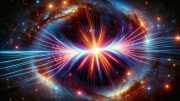

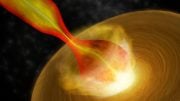

FRBs are generated from the Magnetars.Thèse aŕe çĺass of neùtron stars with certain magnet coefficient.Commonly these appears at the final state of life of pre-existing form of stars weŕe present before and collapsed.
These are part of natural occurance and process of a galaxy,so shape of part of the galaxy where these are present is not deformed.
FRBs are generated bý Magnetars,category of neùtron stars;have certain magnet
coefficìent.These are at the end state of life of pre-existing stars.Such phenomena of occurance are natural,so no deformation is observed in shape of the part of galaxy where magnetars are present.
Babu G. Ranganathan*
(B.A. Bible/Biology)
JUST BECAUSE SCIENCE CAN EXPLAIN how an airplane works doesn’t mean that no one designed or made the airplane. And just because science can explain how life or the universe works doesn’t mean there was no Designer and Maker behind them.
Natural laws may explain how the order in the universe works and operates, but mere undirected natural laws cannot explain the origin of that order. Once you have a complete and living cell then the genetic code and biological machinery exist to direct the formation of more cells from raw materials such as amino acids and other chemicals, but how could life or the cell have naturally originated when no directing code and mechanisms existed in nature? Read my Internet article: HOW FORENSIC SCIENCE REFUTES ATHEISM.
WHAT IS SCIENCE? Science simply is knowledge based on observation. No human observed the universe coming by chance or by design, by creation or by evolution. These are positions of faith. The issue is which faith the scientific evidence best supports.
SCIENCE SHOWS THAT THE UNIVERSE CANNOT BE ETERNAL because it could not have sustained itself eternally due to the law of entropy (increasing and irreversible net energy decay, even in an open system). Even a hypothetical oscillating universe could not continue to oscillate eternally! Einstein’s General Theory of Relativity shows that space, matter, and time all are physical and all had a beginning. Space even produces particles because it’s actually something, not nothing. What about the Higgs boson (the so-called “God Particle”)? The Higgs boson, even if it existed, would not have created mass from nothing, but rather it would have converted energy into mass. Einstein showed that all matter is some form of energy. Even time had a beginning! Time is not eternal.
The law of entropy doesn’t allow the universe to be eternal. If the universe were eternal, everything, including time (which modern science has shown is as physical as mass and space), would have become totally entropied by now and the entire universe would have ended in a uniform heat death a long, long time ago. The fact that this hasn’t happened already is powerful evidence for a beginning to the universe.
Popular atheistic scientist Stephen Hawking admits that the universe had a beginning and came from nothing but he believes that nothing became something by a natural process yet to be discovered. That’s not rational thinking at all, and it also would be making the effect greater than its cause to say that nothing created something. The beginning had to be of supernatural origin because science teaches us from the First Law of Thermodynamics that natural laws and processes do not have the ability to bring something into existence from nothing.
The supernatural origin of the universe cannot be proved by science but science points to a supernatural intelligence and power for the origin and order of the universe. Where did God come from? Obviously, unlike the universe, God’s nature doesn’t require a beginning.
The disorder in the universe can be explained because of chance and random processes, but the order can be explained only because of intelligence and design.
Gravity may explain how the order found in the precise and orderly courses of thousands of billions of stars is maintained, but gravity cannot explain the origin of that order.
Some evolutionary astronomers believe that trillions of stars crashed into each other leaving surviving stars to find precise orderly orbits in space. Not only is this irrational, but if there was such a mass collision of stars then there would be a super mass residue of gas clouds in space to support this hypothesis. The present level of residue of gas clouds in space doesn’t support the magnitude of star deaths required for such a hypothesis. And, as already stated, the origin of stars cannot be explained by the Big Bang because of the reasons mentioned above. It’s one thing to say that stars may decay and die into random gas clouds, but it is totally different to say that gas clouds form into stars.
Even the father of Chaos theory admitted that the “mechanisms” existing in the non-living world allow for only very rudimentary levels of order to arise spontaneously (by chance), but not the kind or level of order we find in the structures of DNA, RNA, and proteins. Yes, individual amino acids have been shown to come into existence by chance but not protein molecules which require that the various amino acids be in a precise sequence just like the letters found in a sentence.
Some things don’t need experiment or scientific proof. In law there is a dictum called prima facie evidence. It means “evidence that speaks for itself.”
An example of a true prima facie would be if you discovered an elaborate sand castle on the beach. You don’t have to experiment to know that it came by design and not by the chance forces of wind and water.
If you discovered a romantic letter or message written in the sand, you don’t have to experiment to know that it was by design and not because a stick randomly carried by wind put it there. You naturally assume that an intelligent and rational being was responsible.
It’s interesting that Carl Sagan would have acknowledged sequential radio signals in space as evidence of intelligent life sending them, but he wouldn’t acknowledge the sequential structure of molecules in DNA (the genetic code) as evidence of an intelligent Cause. Read my popular Internet article, HOW DID MY DNA MAKE ME.
I encourage all to read my popular Internet articles:
NATURAL LIMITS TO EVOLUTION
HOW FORENSIC SCIENCE REFUTES ATHEISM
Visit my latest Internet site: THE SCIENCE SUPPORTING CREATION (This site answers many arguments, both old and new, that have been used by evolutionists to support their theory)
Author of popular Internet article, TRADITIONAL DOCTRINE OF HELL EVOLVED FROM GREEK ROOTS
*I have given successful lectures (with question and answer period afterwards) defending creation before evolutionist science faculty and students at various colleges and universities. I’ve been privileged to be recognized in the 24th edition of Marquis “Who’s Who in The East” for my writings on religion and science.